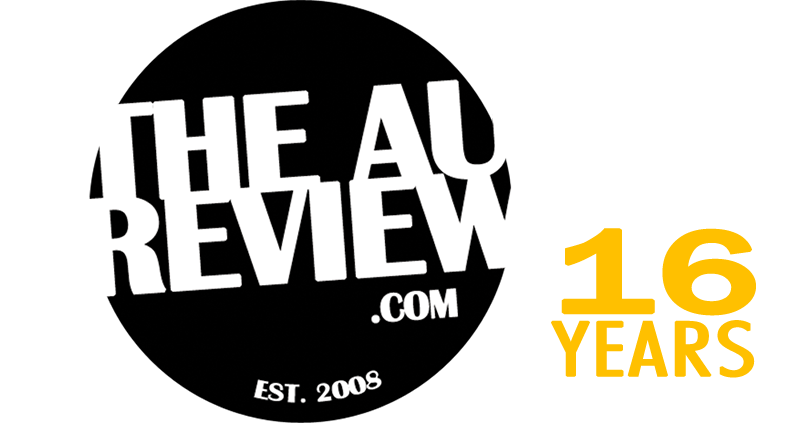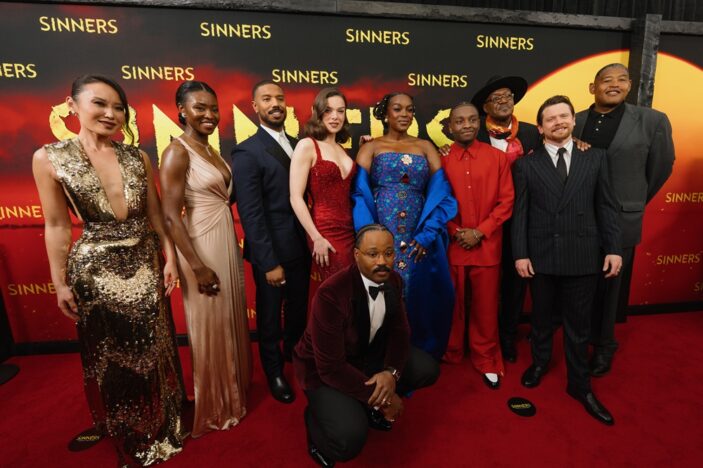
“You keep dancing with the devil, one day he’s gonna follow you home.”
Written and directed by Academy Award-nominated filmmaker Ryan Coogler, Sinners presents a new vision of fear. Starring Michael B. Jordan in a dual role, Academy Award nominee Hailee Steinfeld, Jack O’Connell, Delroy Lindo, Li Jun Li, and Wunmi Mosaku, the film details a duo of twin brothers trying to leave their troubled lives behind, only to discover that an even greater evil is waiting to welcome them back home after their return to start anew.
As it arrives in theatres across the globe (you can read our review here), Peter Gray was invited to an international press conference to hear Coogler and his cast discuss their experiences of making Sinners, including the shorthand between collaborators, the cultural importance of their story, and the cross-section of environment and romance.
Michael B. Jordan and Ryan Coogler have a shorthand after all these years collaborating together
Having worked together multiple times over the course of their careers – Coogler has directed Jordan in all 5 of his feature films (Fruitvale Station, Creed, Black Panther, Black Panther: Wakanda Forever, and now Sinners) – the two have developed something of a shorthand as collaborators. When Jordan was asked about their relationship, he stated that the shorthand had only gotten stronger over the years, especially with their work on Sinners being the first since he himself directed a feature, 2023’s Creed III.
“(I have a) deeper sense of empathy of what Ryan goes through on a day-to-day basis. All the hats that he must wear, the amount of places that he has to be at the same time, especially on this one. For me to be able to be an extra set of eyes for him and help where I can, or anticipate his movements or needs, allowed us to maybe get a little bit more done, especially when time is always an issue on set in general. But it’s a mutual understanding. I can’t really explain the nonverbal communication that we have that’s only gotten better over the years.”
Returning the sentiment, Coogler spoke of how Jordan understood Coogler’s directorial position more so after the actor helmed Creed III.
“Even what he did when he was directing Creed III, he was acting in that movie, you know what I’m saying? He was having to go get punched in the face and then go look and check and see how he did, and then go back and get punched again. I’m not on screen ever when I’m directing. I’m behind the camera. Mike is an empathetic guy. He grew up on film and television sets. What I like the most about working with him is he has an incredible work ethic, but he’s also a very kind and family oriented person. When you’re number one on the call sheet, in this case, he was 1A and 1B, you have that culture. Oftentimes, it’s going to come from there and it trickles down. People are watching how the lead actor communicates with the PA, with the assistant director, the AD, with the camera operator, with the sound. Do they like to let the sound person mic them, or do they want to complain? All of these things, man. He’s such an incredible sport and just moves. Kindness is the default. That’s just infectious on the set in terms of establishing the tone that everybody’s going to work with. It’s unacceptable to yell at a PA if Mike had never done that. You know what I’m saying? Mike had never raised his voice.”
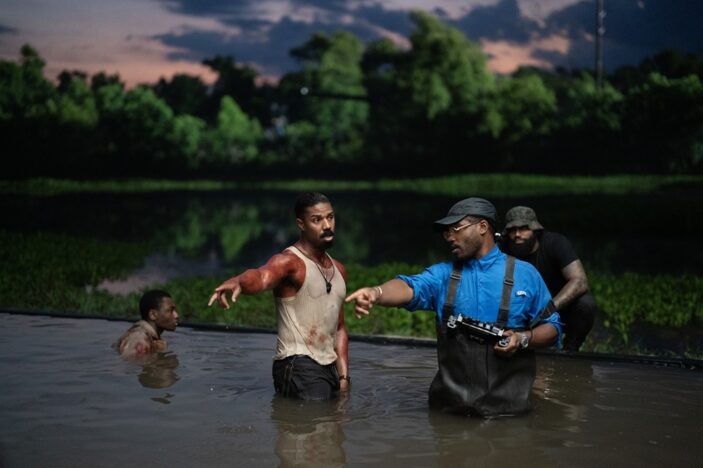
Jack O’Connell is okay with being labelled the villain
The Unbroken actor’s turn as the villainous Remmick may try to encapsulate love and fellowship, but he’s ultimately the bad guy – and the actor is all too comfortable with that description; though he’s aware Coogler’s writing allows his character to step beyond genre stereotypes.
“There’s probably an easier way of doing things, but in the film, we do it the hard way for Remmick. He’s all about fellowship and love. All he wants is just to bite you on your neck, and then that’s everlasting love, just a little bite. He’s constantly saying, “I promise I won’t hurt you.” It’s the easy way, but we end up going the hard way. Listen, there’s a real richness, a real depth, I think, to Ryan’s writing. What we were striving towards was, it wasn’t superficial. It was grounded in something that’s rooted in history. That, to me, was the main thing I was loving to latch onto was the cultural richness that our characters were representing in individual ways.”
Delroy Lindo wasn’t afraid to get physical
Even at 72 years of age, the acclaimed actor wasn’t going to let that – or the fact that his filming dates began after the project was in the swing of filming – deter him from executing Coogler’s specific vision.
“When I was younger, I did dance class, and fighting on film, and in the theater, it’s like choreography, right? It’s choreographed. On some level, the more violent the fights are, the more critically important it is that it be choreographed to a tee. I came to the project a little late because I was working on something else, but when I arrived in New Orleans, they were already in the thick of building the moves in the fight. The very first fight rehearsal that I went to, the fight captain showed me what they were working on and showed me very specifically, “Okay, this is how you will slot in.” We just worked very methodically to achieve that, so by the time we got on camera to shoot those scenes, we all knew exactly what we were doing, what our responsibilities were. The other thing I would say really quickly, there was an openness which trickles down from Ryan and from Mike in terms of the generosity shown to all of the actors. If something was presented to me, there were a couple of things presented to me in the fight scenes where I said, “Can I maybe try this?” Absolutely, there was always space to incorporate what felt more organic for me as an actor.”
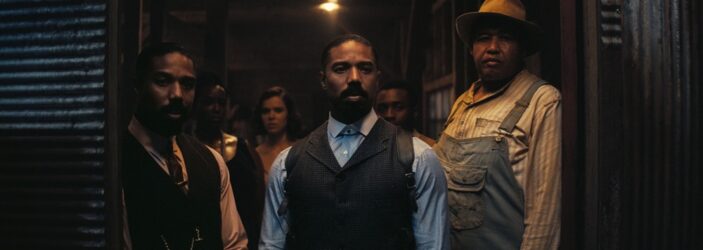
For Li Jun Li, the film was able to speak to a culture separate from the Black experience
When asked about how the Babylon actress crafted her character, she was fascinated to research the Chine-American community of the 1930s.
“I was not aware of the Chinese American community in the Mississippi Delta at all. I had no idea about them. All I knew was that when I was presented with the sides during my audition process, I had no other information other than the fact that she was a Chinese American with a very thick, deep southern accent, which was what really piqued my interest, and also obviously because it was Ryan’s project. When we dived into the research, it was fascinating. They were such a crucial part of the world at the time. They were the only people who were able to open up grocery stores specifically for the Black and white communities, but they also endured a lot of prejudice themselves.”
In a documentary made by a filmmaker named Dolly Li, she mentions a woman, Frieda Kwan, which is whom we used for our dialect inspiration. She always said that as long as we stayed in our lanes, we were fine, but trouble would start if we crossed over. I just love how fascinating it was, how deeply embedded they were in the culture and how you would never think that a person who looks like me would speak that way, and yet they did. They also made southern-style Chinese food and they built their own community. It was really a gift to learn about this.”
It’s all about the environment of romance for Wunmi Mosaku and Hailee Steinfeld
Each representing an intense love story for the two brothers at the centre of the film, Smoke and Stack, Mosaku’s Annie and Steinfeld’s Mary bring a certain intimacy and eroticism to the film. But more than that, each actress had a deep reaction to the Louisiana wildlife and the realistic environment created to help invest further to their characters.
Mosaku spoke of the shaded oak trees and pussy willows that added a sense of magic to her on-screen relationship with Smoke; “There’s smoke coming up through the floorboards and there were these little cards hanging from the ceiling. This candle’s burning in the background. You can’t see all of this. There were spider webs on these spell books. These are real spiders. It’s not even set design. It just felt really magical. It felt like their home. When he comes into the store, he knows where to pick his pipe from. He knows that time has stood still for her and everything is as it was. Yeah, I really loved their environment. It felt like it really added to the scene, it added to our intimacy, it added to our connection. Then having the grave right there, knowing when Annie says, “I don’t need any other money because I’m not going anywhere else,” that is her anchor. Her heart is right there in the ground and right there in front of her.”
Steinfeld added, “That was one set I wish I got to see in person because I had heard about it and seeing it in the movie, the thought of there being more of that is just, because what you see is so spectacular. The note about him knowing where the pipe is and knowing where to go and that being your home… I think the nights were crazy, and a lot of the nights took place inside the juke, too. We would go in and it would be light and we’d come out, it’d be light again.”
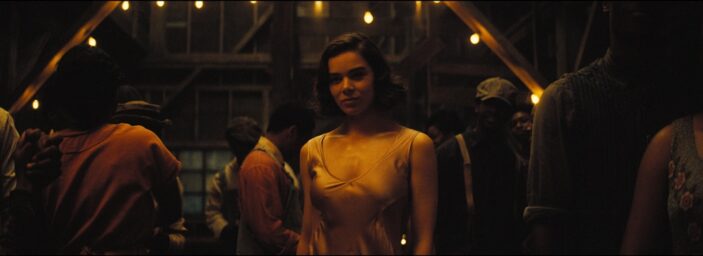
“What I loved, though, so much about the juke for Mary was that even though it was a new place to her, it was home. There were so many elements within that juke that were created, that were brought to life, that were home. The food, the people, most importantly, the music, just the way, the layout where you’d have Smoke and Stack up above, Annie in her corner, the stage and Mary just moving through and feeling this sense of familiarity having never been there before because of who was around her. I love that so much about this character and how she falls into this story because she’s in a place of not knowing whether or not she, to an outsider, not so much herself. An outsider may not believe that she belongs in that space, but she does. She knows that and she feels it.”
“Being in that juke, being on that stage and even in our exterior location, looking at that structure that was built, it was like it became our home. It became Mary’s home. It became her connection to her mother and her past that she’d been away from for so long, living a very, very different life that we didn’t necessarily see, but we could only imagine how beautiful it might’ve been or looked, rather, or how different it might’ve looked. It wasn’t what she wanted. This is home. I loved walking in there and hearing everyone’s shoes creak on the wood and the chairs that, we see a little bit in the movie of the juke coming together. It’s just like you wonder where it all came from and how they got it all together. It was all these people that are in there that made it happen, that brought it together. We had just the most incredible team, some of who you mentioned, bring this to life and make this feel like a safe space that we could call home.”
Sinners is screening in Australian theatres from April 17th, 2025.
